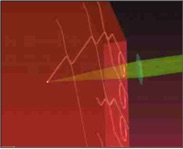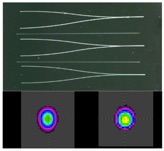The ALSI Project

The ALSI project aims at developing new photonic-based technologies for next generation astronomical instrumentation. Integrated optics circuits are particularly valuable for large interferometers such as the Very Large Telescope Interferometer in Chile, where astronomers want to interferometrically combine the numerous beams coming from the different telescopes . Using integrated optics solutions permit to reduce complex optical designs to small scale optical chips that offer superior performances. Integrated optics technology is a new cutting-edge solution that is for instance employed for the next-generation instrument GRAVITY at the VLTI.
In this context, the ALSI project focuses on implementing the ultrafast laser-writing technique in infrared glasses - pioneered by different groups in Europe - to extend towards the 3-10 microns mid-infrared range the usage of integrated optics for beam combination and fringe-tracking in infrared stellar interferometry. While promising works and results have already been achieved in the past, ALSI targets the full development of a low-loss component satisfying several of the stringent astronomical requirements. Within the ALSI consortium, the various aspects connected to the manufacturing, lab characterization and system analysis phases have been ideally distributed according to the competencies existing in the project.
The participants to the ALSI project are:
-
-The 1st Physics Institute of the University of Cologne and the Institute of Applied Physics of the University of Jena, leading partners of the project.
-
-The Max-Planck Institute of Astronomy in Heidelberg, associate partner
-
-The Heriot-Watt University in Edinburgh, UK, external collaborator
The project is funded by the German Ministry of Research (Bundesministerium für Bildung und Forschung)
Advanced Laser-writing for Stellar Interferometry




© G. Brammer, STSCI